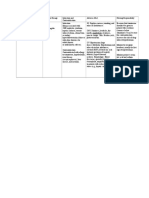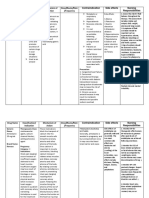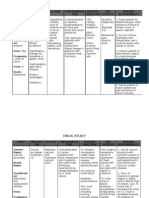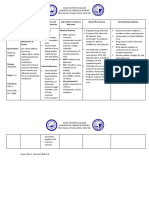Octreotide
Octreotide
Uploaded by
Hatim DziauddinCopyright:
Available Formats
Octreotide
Octreotide
Uploaded by
Hatim DziauddinCopyright
Available Formats
Share this document
Did you find this document useful?
Is this content inappropriate?
Copyright:
Available Formats
Octreotide
Octreotide
Uploaded by
Hatim DziauddinCopyright:
Available Formats
DRUG GUIDELINE
OCTREOTIDE (Intravenous – bleeding oesophageal varices)
SCOPE (Area): FOR USE IN: Critical Care Unit, ED, Theatre and General Wards
EXCLUSIONS: Paediatrics (seek Paediatrician advice)
SCOPE (Staff): Medical, Nursing and Pharmacy
BRAND NAMES
Sandostatin®.
Octreotide Acetate DBL®.
Octreotide MaxRx®.
________________________________________________________________________________
PHARMACOLOGY AND PHARMACOKINETICS
Octreotide is a longer acting synthetic analogue of the naturally occurring hormone somatostatin
(growth hormone inhibiting peptide). It inhibits the secretion of serotonin, gastoenteropancreatic
peptides (gastrin, glucagon, insulin, motilin, pancreatic polypeptide, secretin and vasoactive
intestinal peptide [VIP]) and growth hormone. Octreotide is a splanchnic arteriolar vasoconstrictor,
reducing splanchnic blood flow and portal pressure. Octreotide is both hepatically and renally
cleared with a half life of 1.5 hours.
________________________________________________________________________________
INDICATIONS
▪ Bleeding oesophageal varices (adjunct to banding/sclerotherapy/surgery).
▪ Other indications of octreotide (including the use of long acting octreotide) are not covered
by this guideline.
________________________________________________________________________________
CONTRAINDICATIONS
▪ Hypersensitivity to octreotide.
________________________________________________________________________________
PRECAUTIONS
▪ Diabetes - octreotide can increase or decrease blood glucose. Monitor carefully and adjust dose
of insulin or oral antidiabetic medications if necessary.
▪ Insulinoma - increased risk of severe and prolonged hypoglycaemia when used with octreotide.
________________________________________________________________________________
PREGNANCY AND BREASTFEEDING
Seek specialist advice before prescribing, information may update regularly.
________________________________________________________________________________
DRUG INTERACTIONS
▪ Drugs that prolong the QT interval - Octreotide may prolong the QT interval further,
especially drugs with a stronger QT interval effect (e.g. amiodarone, cisapride, citalopram,
DRG0029: Octreotide (Intravenous - bleeding oesophageal Ratification Date: February 2014
varices) Review Date: February 2019 Version 3
UNCONTROLLED COPY IF PRINTED Page: 1 of 3 See BHS Intranet for current version
escitalopram, disopyramide, flupenthixol, paliperidone, quetiapine, quinine, sotalol, thioridazine,
ziprasidone, zuclopenthixol). Monitor QT interval where relevant.
▪ Medications affecting blood glucose concentration - octreotide can increase or decrease blood
glucose concentration.
▪ Cyclosporin - octreotide may cause a reduction in the absorption of cyclosporin.
▪ Opioids – octreotide may decrease the analgesic effects of opioids by an unknown mechanism.
DOSAGE AND ADMINISTRATION
For administration
▪ in Critical Care Unit, ED and Theatre
▪ in General Wards
Administer via CVC, midline or peripheral line.
Note: IV infusions are to be prepared with 0.1 mg/1 mL ampoules (stocked in CCU). A
higher strength ampoule (0.5 mg/1 mL) is stocked in the Pharmacy and reserved for higher
dose subcutaneous infusions for palliative care patients. The packaging for both strengths is
similar, always check carefully to ensure correct strength has been selected.
Although compatible, it is recommended not to dilute in glucose 5% as octreotide can
increase or decrease blood glucose levels.
IV injection (loading dose prior to infusion):
Use octreotide 0.1 mg/1 mL ampoules.
Octreotide 50 microgram (0.5 mL from 0.1 mg/1 mL ampoule) undiluted over 3 mins.
IV infusion following loading dose (via CVC, midline or large peripheral vein):
Use octreotide 0.1 mg/1 mL ampoules to prepare infusion.
Withdraw 5 mL from a 100 mL sodium chloride 0.9% minibag.
Octreotide 0.5 mg (5 mL from FIVE 0.1 mg/1 mL ampoules) added to remaining 95 mL sodium
chloride 0.9% in the minibag.
Total Volume: 100 mL.
Final concentration: 5 microgram/mL.
Rate range: 25-50 microgram/hr (5-10 mL/hr).
Maximum rate: 50 microgram/hr (10 mL/hr).
Length of infusion: As decided by Gastrointestinal Unit, usually for 48 hours (up to 5 days has
been used).
Syringe Pump IV infusion:
**For use in ED only**
Use octreotide 0.1 mg/1 mL ampoules to make up infusion.
Octreotide 0.25 mg (2.5 mL from three 0.1 mg/1 mL ampoules) diluted to 50 mL with sodium
chloride 0.9% in a luer lock syringe.
Total Volume: 50 mL.
Final concentration: 5 microgram/mL.
Rate: as for IV infusion above.
DRG0029: Octreotide (Intravenous - bleeding oesophageal Ratification Date: February 2014
varices) Review Date: February 2019 Version 3
UNCONTROLLED COPY IF PRINTED Page: 2 of 3 See BHS Intranet for current version
General Administration Information
▪ Infusion preparation:
Mix infusion thoroughly after adding octreotide to avoid inadvertently giving a more
concentrated dose.
Discoloured solutions or solutions with particulate matter should not be used.
Sodium chloride 0.9% can be substituted for different compatible IV fluid as requested by the
Medical Officer.
Infusion stable for 24 hours.
▪ Infusion pump: Volumetric pump.
▪ Routes of administration:
IV injection: Yes
IV intermittent infusion: Yes
IV continuous infusion: Yes
IM injection: No
Subcut injection: Yes
▪ Compatible/incompatible IV drugs/fluids:
Consult the Australian Injectable Drugs Handbook (‘Yellow book’) in your ward area. Assume
all unlisted drugs and IV fluids are incompatible – contact Pharmacy for further advice.
________________________________________________________________________________
MONITORING (INCLUDING BLOOD TESTS)
▪ Consider QT interval monitoring via ECG where relevant (see Drug Interactions).
________________________________________________________________________________
NURSING PRACTICE POINTS
▪ Monitor blood glucose.
________________________________________________________________________________
ADVERSE EFFECTS
▪ Common – abdominal pain, flatulence, nausea, vomiting, diarrhoea, gallstones, fatigue,
hyperglycaemia, hypoglycaemia, local transient reaction at injection site.
▪ Rare – hypothyroidism, pancreatitis, hepatic dysfunction, bradycardia.
________________________________________________________________________________
DRUG PRESENTATIONS, LOCATION AND STORAGE
Octreotide (acetate) 100 mcg/1 mL ampoules and 500 mcg/1 mL ampoules.
Note: 100 microgram = 0.1 mg, 500 microgram = 0.5 mg.
Imprest locations (at the time of guideline development): 0.1 mg/1 mL - CCU.
Store at 2-8°C. Protect ampoules from light.
________________________________________________________________________________
DRG0029: Octreotide (Intravenous - bleeding oesophageal Ratification Date: February 2014
varices) Review Date: February 2019 Version 3
UNCONTROLLED COPY IF PRINTED Page: 3 of 3 See BHS Intranet for current version
You might also like
- Drug NeurontinDocument1 pageDrug NeurontinSrkocher100% (2)
- Katamino RulesDocument8 pagesKatamino RuleslejozsefNo ratings yet
- Power Words: Words That Will Win Your Ex BackDocument20 pagesPower Words: Words That Will Win Your Ex Backderek652853% (15)
- Drug Study Table 3Document5 pagesDrug Study Table 3Juliet De GuzmanNo ratings yet
- 04,05 - MEP Specifications PDFDocument842 pages04,05 - MEP Specifications PDFrakeshamechNo ratings yet
- AlendronateDocument3 pagesAlendronateAdhaNo ratings yet
- Drug Name Mecahnism of Action Indication Side Effects Generic NameDocument2 pagesDrug Name Mecahnism of Action Indication Side Effects Generic NamehahahaNo ratings yet
- Metronidazole 500mg/tab 1 Tab 3xadayDocument4 pagesMetronidazole 500mg/tab 1 Tab 3xadayCrisyl LipawenNo ratings yet
- Drug Study OrthoDocument4 pagesDrug Study OrthoJhessa Curie Pitagan100% (1)
- Drug StudyDocument17 pagesDrug StudyTherese ArellanoNo ratings yet
- Drug Study RopivacaineDocument2 pagesDrug Study Ropivacainerica sebabillonesNo ratings yet
- Drug Study QIDocument8 pagesDrug Study QImaeDonitaNo ratings yet
- Mupirocin Drug StudyDocument3 pagesMupirocin Drug StudymichelleNo ratings yet
- BisoprololDocument2 pagesBisoprololNovi YulianaNo ratings yet
- DigoxinDocument4 pagesDigoxinJaessa FelicianoNo ratings yet
- TriamtereneDocument2 pagesTriamtereneRox SanNo ratings yet
- Nahco3 Vancomycin AmlodipineDocument3 pagesNahco3 Vancomycin AmlodipineShan Dave TupasNo ratings yet
- DrugsDocument10 pagesDrugsRebecca JolieNo ratings yet
- Mitomycin - UsmanDocument3 pagesMitomycin - UsmanSittie Nashieva A. UsmanNo ratings yet
- Generic Name: Brand Name: Pletal: Pharmacologic Class: Pharmacokinetics General Indications Contraindications BeforeDocument2 pagesGeneric Name: Brand Name: Pletal: Pharmacologic Class: Pharmacokinetics General Indications Contraindications Beforeart_mutantNo ratings yet
- Verapamil HCLDocument3 pagesVerapamil HCLMae Ann Bueno CastillonNo ratings yet
- DRug Study PhenytoinDocument1 pageDRug Study Phenytoinmichelle marquezNo ratings yet
- Drug Study AzithromycinDocument2 pagesDrug Study Azithromycinkuro hanabusaNo ratings yet
- Drug Study (Pe)Document15 pagesDrug Study (Pe)Jobelle AcenaNo ratings yet
- Drug Study 2Document8 pagesDrug Study 2rey_tengNo ratings yet
- Drug StudyDocument6 pagesDrug Studyjay kusainNo ratings yet
- LetrozoleDocument2 pagesLetrozoleunkown userNo ratings yet
- Zinc SulfateDocument1 pageZinc SulfateAnna LaritaNo ratings yet
- Micromonospora Purpurea. Action IsDocument3 pagesMicromonospora Purpurea. Action IsCarlos H. AcuñaNo ratings yet
- Linezolid (Zyvox)Document1 pageLinezolid (Zyvox)ENo ratings yet
- OxacillinDocument1 pageOxacillinSergi Lee OrateNo ratings yet
- Drug Study ValiumDocument2 pagesDrug Study ValiumRhea Liza Comendador-TjernmoenNo ratings yet
- RifampicinDocument2 pagesRifampicinChaeL90No ratings yet
- Tramadol Drug-StudyDocument3 pagesTramadol Drug-StudyPang ProjectNo ratings yet
- Drug Study: Notre Dame of Tacurong CollegeDocument2 pagesDrug Study: Notre Dame of Tacurong CollegeApol PenNo ratings yet
- Insulin As PartDocument3 pagesInsulin As PartRezaNo ratings yet
- EstradiolDocument1 pageEstradiol3S - JOCSON, DENESE NICOLE LEE M.No ratings yet
- Paracetamol - DSDocument3 pagesParacetamol - DSEnoch LabianoNo ratings yet
- Drug StudyDocument15 pagesDrug StudyDavid RefuncionNo ratings yet
- Drug Study Ciprofloxacin QuinosynDocument10 pagesDrug Study Ciprofloxacin QuinosynNelle ReyNo ratings yet
- Cetirizine 2Document2 pagesCetirizine 2ianNo ratings yet
- Epirubicin 10Document1 pageEpirubicin 10PdianghunNo ratings yet
- NCP Notes Acute GlomerulonephritisDocument3 pagesNCP Notes Acute GlomerulonephritisMargareth DandanNo ratings yet
- CALCITRIOLDocument2 pagesCALCITRIOLdesshe09No ratings yet
- AmoclavDocument2 pagesAmoclavianecunarNo ratings yet
- Drug Study AtropineDocument3 pagesDrug Study AtropineAerron Severus Secano ShuldbergNo ratings yet
- GAT NCP Surgery WardDocument4 pagesGAT NCP Surgery WardDon Richard0% (1)
- Brand Name:: VasopressinDocument3 pagesBrand Name:: VasopressinHannah BuquironNo ratings yet
- Drug StudyDocument3 pagesDrug StudyMarychen Cabunas100% (1)
- Generic Name:: ClassificationsDocument4 pagesGeneric Name:: ClassificationsbillyktoubattsNo ratings yet
- BNP (C)Document2 pagesBNP (C)Mae Ann Bueno CastillonNo ratings yet
- Amikacin 2Document2 pagesAmikacin 2Sian AsadaNo ratings yet
- DrugStudy - CamaristaColeenMaeC (BSN III-G) (Prednisone)Document2 pagesDrugStudy - CamaristaColeenMaeC (BSN III-G) (Prednisone)Coleen Mae CamaristaNo ratings yet
- Atropine SulfateDocument2 pagesAtropine SulfateKureaa OhNo ratings yet
- PiptazDocument3 pagesPiptazArone SebastianNo ratings yet
- Drug Study DoxycyclineDocument1 pageDrug Study DoxycyclineCruzado April Kyl DC.BSN - 2BNo ratings yet
- Tamsulosin - Drug Information - UpToDateDocument23 pagesTamsulosin - Drug Information - UpToDateGénesis GabrielaNo ratings yet
- Drug Study LevofloxacinDocument2 pagesDrug Study LevofloxacinDannah BulliandayNo ratings yet
- Atropine SulfateDocument1 pageAtropine SulfateTrishaaMayolNo ratings yet
- The Ride of Your Life: What I Learned about God, Love, and Adventure by Teaching My Son to Ride a BikeFrom EverandThe Ride of Your Life: What I Learned about God, Love, and Adventure by Teaching My Son to Ride a BikeRating: 4.5 out of 5 stars4.5/5 (2)
- SandostatinDocument3 pagesSandostatinTarek yahiaNo ratings yet
- CeftriaxoneDocument2 pagesCeftriaxoneMaryann Lorraine LegaspiNo ratings yet
- DEXTROSE AND SODIUM CHLORIDE-dextros e and S Odium Chloride Injection, S Olution Baxter Healthcare CorporationDocument30 pagesDEXTROSE AND SODIUM CHLORIDE-dextros e and S Odium Chloride Injection, S Olution Baxter Healthcare CorporationSulistiaNo ratings yet
- Airport Display SolutionsDocument16 pagesAirport Display SolutionsHatim DziauddinNo ratings yet
- Tranexamic Acid Injection 500 MG/ 5 ML Ampoule New Zealand Data SheetDocument18 pagesTranexamic Acid Injection 500 MG/ 5 ML Ampoule New Zealand Data SheetHatim DziauddinNo ratings yet
- Exam Dates Final Candidates 2015Document2 pagesExam Dates Final Candidates 2015Hatim DziauddinNo ratings yet
- Rapid Sequence Intubation: Mask and MonitoringDocument6 pagesRapid Sequence Intubation: Mask and MonitoringHatim DziauddinNo ratings yet
- DCOM 2015 Registration FormDocument2 pagesDCOM 2015 Registration FormHatim DziauddinNo ratings yet
- Hecat Module SHDocument70 pagesHecat Module SHHatim DziauddinNo ratings yet
- Teaching Feb 2015Document3 pagesTeaching Feb 2015Hatim DziauddinNo ratings yet
- GINA Report 2015 Aug11Document149 pagesGINA Report 2015 Aug11Alex Medina AguilarNo ratings yet
- What Is A Dental AbscessDocument10 pagesWhat Is A Dental AbscessHatim Dziauddin100% (1)
- Guideline For Silk-Road Scholarship (Fall 2021)Document2 pagesGuideline For Silk-Road Scholarship (Fall 2021)Элнура Анарбай кызыNo ratings yet
- LESSON 1 Teaching English in Elem GradesDocument8 pagesLESSON 1 Teaching English in Elem Gradesbaunsit.josepharnold.mccNo ratings yet
- 5.1y Review WorksheetDocument2 pages5.1y Review WorksheetDyuNo ratings yet
- English Project Topics 2023-24Document5 pagesEnglish Project Topics 2023-24Pratyush Jain75% (8)
- Alpha Charger c25Document24 pagesAlpha Charger c25Muhammad SyukurNo ratings yet
- On The Ruling of TawassulDocument16 pagesOn The Ruling of TawassulFP100% (1)
- Past-Tenses 62248Document3 pagesPast-Tenses 62248Gabriela LazarteNo ratings yet
- Kuboja PHD Thesis SubmittedDocument142 pagesKuboja PHD Thesis SubmittedFalmata AtNo ratings yet
- Farmers Dreams Walkthrough 2Document13 pagesFarmers Dreams Walkthrough 2FarhadFaisal0% (1)
- Service Manual: HCD-GR8000Document16 pagesService Manual: HCD-GR8000Vitorio LogoNo ratings yet
- LOVE AND THE LAW - Charlie Orly December 9-11-2009Document13 pagesLOVE AND THE LAW - Charlie Orly December 9-11-2009Jack Ryan0% (1)
- 30JAN18 LA PER 18 2206 CEDINCO Cooperation Agreement EnglishDocument12 pages30JAN18 LA PER 18 2206 CEDINCO Cooperation Agreement EnglishGUIDO DARI QUISPE ROJASNo ratings yet
- 6.Dr. Neeraj GohilDocument8 pages6.Dr. Neeraj Gohilkeerthi kumariNo ratings yet
- Resolva As Tag Questions Abaixo Como Estudamos em Sala. Exemplo: It's Very ColdDocument4 pagesResolva As Tag Questions Abaixo Como Estudamos em Sala. Exemplo: It's Very ColdY 1 K 3 SNo ratings yet
- DCC3113 - Chapter 5 PDFDocument24 pagesDCC3113 - Chapter 5 PDFXkarr Rasta100% (1)
- Pierlite-Dled9 Led TrofferDocument2 pagesPierlite-Dled9 Led TrofferPiZarezČetrnaestNo ratings yet
- Unit 9 Test: Speaking: Photo DescriptionDocument1 pageUnit 9 Test: Speaking: Photo DescriptionTTNLittleGeniusNo ratings yet
- 00 Midgard RPGDocument2 pages00 Midgard RPGPaul SavvyNo ratings yet
- United Kingdom Criminal (Basic Disclosure ANI) Professional Evidence of IDDocument5 pagesUnited Kingdom Criminal (Basic Disclosure ANI) Professional Evidence of IDHamid MehamedNo ratings yet
- Through The Mushroom ForestDocument6 pagesThrough The Mushroom ForestMatheus RomaNo ratings yet
- Annelida PresentationDocument20 pagesAnnelida PresentationtariNo ratings yet
- AccreditationDocument35 pagesAccreditationSatish PatilNo ratings yet
- Prudentia Monsoon Mania 2021 (Competition Categories)Document2 pagesPrudentia Monsoon Mania 2021 (Competition Categories)prii_jazzNo ratings yet
- WEEK 1 - Schwind Chapter 2-Part 1 - HRMDocument13 pagesWEEK 1 - Schwind Chapter 2-Part 1 - HRMBerna Dela CruzNo ratings yet
- Visual Web Developer 2005 Express EditionDocument244 pagesVisual Web Developer 2005 Express EditionGeña GonzalesNo ratings yet
- Daniel M'Naghten's Case (1843) 8 ER 718Document7 pagesDaniel M'Naghten's Case (1843) 8 ER 718angelikahsuNo ratings yet
- Biology Quiz For SS2Document2 pagesBiology Quiz For SS2onyenco89No ratings yet


































































































